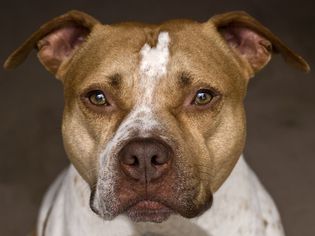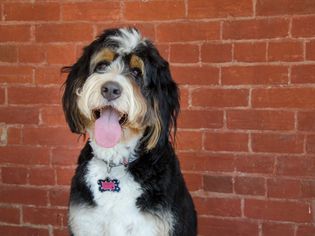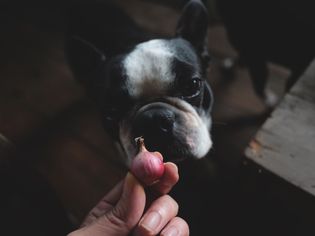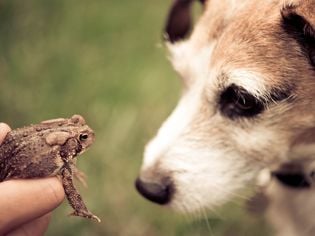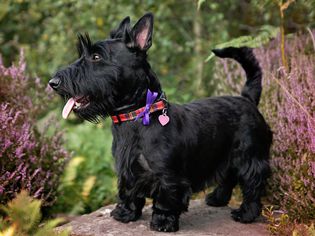The Perro de Presa Canario is a robust breed from the Canary Islands of Spain. The name of the breed is Spanish in origin, translating to “canary catch dog,” and it's often shortened to Presa Canario. When properly trained and socialized, the Presa Canario is docile, devoted, and obedient to their family—however, they are natural guard dogs, highly suspicious of strangers, and will sometimes act aggressively toward people or animals they don’t know.
With a thick and muscular rectangular body, attentive expression, and black mask, the Presa Canario is a strong-willed breed. Their broad, brachycephalic head shape usually features cropped ears, which add to their formidable expression and also keep them safe while working with cattle.
Learn all about the Perro de Presa Canario, including the breed’s care needs, characteristics, and history.
Breed Overview
GROUP: Working
HEIGHT: 22 to 26 inches
WEIGHT: 84 to 110 pounds
COAT: Short and coarse
COAT COLOR: Brown/black, fawn, or brindle; occasionally with white markings
LIFE SPAN: 9 to 11 years
TEMPERAMENT: Calm, gentle, stubborn, alert, bold, stubborn
HYPOALLERGENIC: No
ORIGIN: Spain
Characteristics of the Presa Canario
While initially slow to warm up, the Presa Canario has a gentle and sweet disposition, especially around people they trust. They are a confident breed, with an even keel and large presence. The Presa Canario’s stance is firm and vigilant, combined with a calm and confident temperament.
This is a good breed for home security. On the other hand, these dogs are actually quite quiet, which makes them good for people who don’t want a loud home.
The Presa Canario is a different breed from the cane corso, though they are both mastiff breeds that are similar in height, weight, coat, and overall appearance. The cane corso is a working breed from Italy, and these dogs are gentle, quiet, calm, stable, even-tempered, and reserved, making them similar in personality to the Presa Canario.
| Affection Level | Medium |
| Friendliness | Medium |
| Kid-Friendly | Medium |
| Pet-Friendly | Medium |
| Exercise Needs | High |
| Playfulness | Medium |
| Energy Level | High |
| Trainability | High |
| Intelligence | High |
| Tendency to Bark | Medium |
| Amount of Shedding | Low |
History of the Presa Canario
Traditionally used for herding cattle, an intimidating appearance and hyper-awareness make the Presa Canario an ideal guard dog. The breed is said to date back to the 15th and 16th centuries after the conquest of the Canary Islands. At the time, people used large dogs for various tasks, such as working cattle, removing stray and wild dogs, and protecting farms.
The roots of the Presa Canario can be traced back to the cattle breed, Iberian Presa (Perro de Ganado Majorero), an average-size mastiff breed and intuitive guard dog. Several other breeds may have contributed to the formation of the Presa Canario—in particular, the Presa Espanol, as well as the Bardino Majorero, a sheepdog from Fuerteventura.
Over time, these island dogs evolved into differentiated breeds, and the Presa Canario became known for intelligence, courage, and physical resistance, along with an ability to exude natural guardian instincts, even without the need for excessive barking. Not surprisingly, these dogs were also often bred for dogfighting.
During the 1940s, dogfighting was prohibited. People secretly continued to hold dogfights for many years, but the number of Presa Canario dogs began to decline. The breed suffered even more as people became more interested in other breeds like the Great Dane, German Shepherd, and Doberman Pinscher. This nearly caused the extinction of Presa Canarios who were then used as guard dogs for herdsmen and farmers.
Fortunately, during the 1970s, breeders focused on the Presa Canario, breeding dogs that were brave, protective, territorial, headstrong, and massive. Starting in 1982, breeders from Tenerife worked on recovering the Presa Canario. Today, the breed serves as the animal symbol of Gran Canaria and has been recorded in the Foundation Stock Service since 1996.
Are Presa Canarios legal in the US?
Due to their territorial tendencies, the Presa Canario has been banned from several countries. The breed is allowed in the United States, but not currently recognized by the American Kennel Club. However, they are accepted by the AKC Foundation Stock Service, which provides a secure location for its records and permits the dogs to compete in AKC companion events.
Presa Canario Care
While protective and devoted to family, this breed is generally better suited for experienced, active dog parents who can properly socialize their Presa Canario and provide ample opportunity for outdoor activity.
Because of its history as a guard dog, the breed is strong-willed, powerful, intelligent, and very suspicious of strangers—and, therefore, may require increased opportunities for socialization and training early in life to safely interact with others, particularly in a home with children or other pets.
Exercise
This high-energy breed will crave daily exercise, including playtime outdoors or multiple walks each day. These dogs can also learn indoor games like hide-and-seek or new tricks, as they're eager to please and highly trainable.
The Presa Canario’s robust, muscular physique and athletic prowess mean they can engage in higher-intensity outdoor activities like swimming, hiking, and retrieving balls or flying discs.
This dog’s large size could cause them to accidentally hurt someone. So, they may be unsuitable for some, especially those with small children and other small pets.
Grooming
The Perro de Presa Canario will require occasional bathing to keep the short coat clean but requires regular brushing given the amount this breed sheds.
This breed also boasts strong, fast-growing nails that will need to be frequently trimmed with a nail clipper or a nail grinder. The dog’s short ears should be checked on a routine basis, and teeth should be brushed regularly.
Training
These dogs can be calm, affectionate, and obedient, but only with the proper training from experienced dog parents. They have a powerful natural instinct to attack anything that appears to be a threat.
Intensive socialization and obedience training as puppies and beyond is crucial for the Presa Canario breed, and they will respond best to fair, consistent training and clear limits.
Common Health Problems
Overall, the majority of Perro de Presa Canarios are healthy dogs. Due to their larger size, the Presa Canarios can be susceptible to:
- Hip or joint dysplasia: These conditions cause abnormalities in the joints that can lead to symptoms like mobility problems, pain, and lameness.
- Heart problems: Presa Canarios are at risk of dilated cardiomyopathy (DCM), which causes the heart to enlarge and ineffectively pump blood.
- Eye problems: Conditions like cataracts (causes the lens of the eye to become cloudy, reducing vision) and canine multifocal retinopathy (causes retinal detachment) can affect Presa Canarios.
- Epilepsy: This is a neurological disorder that causes seizures. Dogs diagnosed with this condition need to receive treatment from a veterinarian.
- Canine Leishmaniasis: This is a disease caused by Leishmania parasites that are transmitted from the bite of an infected phlebotomine sandfly.
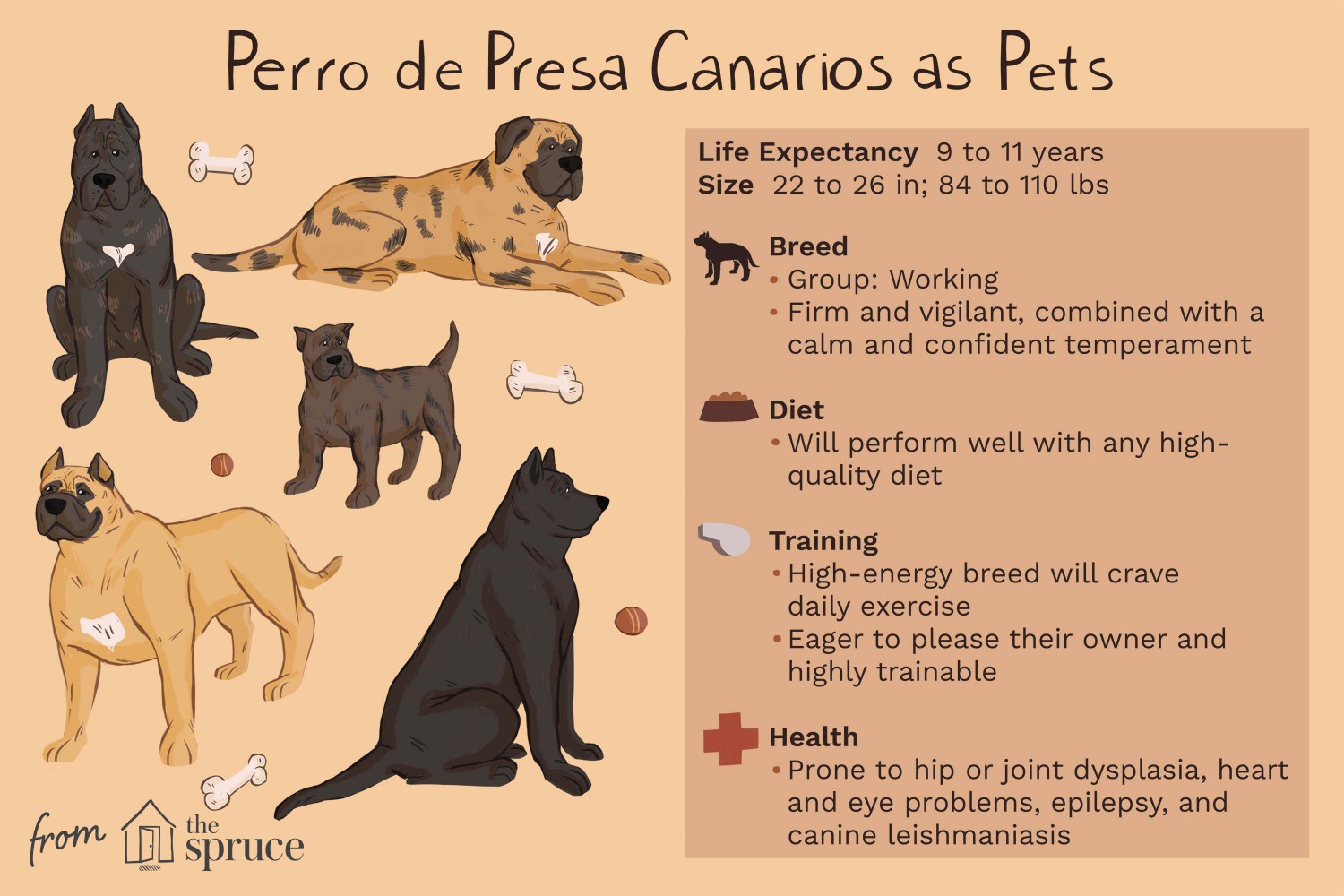
Illustration: The Spruce / Emilie Dunphy
Diet and Nutrition
The Presa Canario will perform well with any high-quality diet, whether their food is commercially prepared or cooked at home (with guidance from a veterinarian). As a larger, active breed, they may require more water than the average dog, and may also prefer higher-protein food.
Where to Adopt or Buy a Perro de Presa Canario
If you’re considering bringing a Perro de Presa Canario home, you’re probably wondering, “How much does a Presa Canario cost?” They are expensive; you can expect to pay anywhere from $2,000 to $3,500, on average, for a puppy from a reputable breeder.
Although the Presa Canario is not eligible for registration with the American Kennel Club, it is possible to find a reputable breeder. The United Perro de Presa Canario Club provides referrals to breeders, and the best way to find a Presa Canario rescue is to research rescue groups online.
Perro de Presa Canarios Overview
The Perro de Presa Canario is an impressive breed that can be a great match for someone looking for a protective and loyal dog. Although easy when it comes to grooming, these dogs require a lot of your time and effort when it comes to training and exercise.
They’re best suited for experienced dog parents, not first-time dog parents. They require people who can handle big dogs and be consistent with training and socialization to prevent unwanted behaviors.
Pros of Perro de Presa Canarios
- Highly intelligent
- Easy to train
- Loves to play outdoors and perform tricks
Cons of Perro de Presa Canarios
- Needs a lot of exercise
- May not be suitable for families with young children due to attack instincts
- Needs intensive socialization and obedience training
More Dog Breeds and Further Research
When determining if the Presa Canario is the right dog for you, be sure to research all aspects of the breed and consult other Presa Canario owners, breeders, and rescue groups to learn more.
If you’re interested in similar breeds, check out:
- Cane Corso
- Mastiff
- Great Dane
There’s a whole world of potential dog breeds out there—with a little research, you can find the right one to bring home!
- How much does a Presa Canario cost?
Presa Canario puppies can cost from $2,000 to $3,500.
Is a Presa Canario a good family dog?The Presa Canario can make a good family dog when properly trained and socialized. They have many attractive characteristics, but may not be appropriate for first-time dog parents and families with small children and pets.
What is the difference between a cane corso and Presa Canario?These breeds are very similar, but the cane corso is from Italy while the Presa Canario is from Spain. They’re both working breeds—the cane corso was used for hunting and guarding, and the Presa Canario was used for herding and guarding.
What were Presa Canarios used for?Presa Canarios were traditionally used as herding dogs.
More like this



